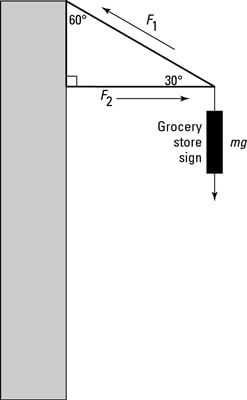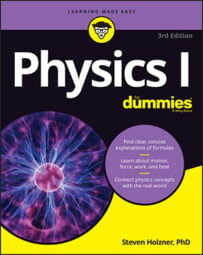In physics, an object is in equilibrium when it has zero acceleration — when the net force acting on it is zero. The object doesn’t actually have to be at rest, as in the example below, which uses a pulley to suspend a sign — it can be going 1,000 miles per hour as long as the net force on it is zero and it isn’t accelerating. Forces may be acting on the object, but they all add up, as vectors, to zero.

For example, take a look at the figure, where you’ve started your own grocery store and bought a wire rated at 15 newtons to hang the sign with.
The sign weighs only 8.0 newtons, so hanging it should be no problem, right? Actually, you do have a problem here. Coolly, you get out your calculator to figure out what force the wire, F1 in the diagram, has to exert on the sign to support it. You want the sign to be at equilibrium, which means that the net force on it is zero. Therefore, the entire weight of the sign, mg, has to be balanced out by the upward force exerted on it.
In this case, the only upward force acting on the sign is the y component of F1, where F1 is the tension in the wire, as you can see in the figure. Force exerted by the horizontal brace, F2, is only horizontal, so it can’t do anything for you in the vertical direction. Using your knowledge of trigonometry, you can determine from the figure that the y component of F1 is
To hold up the sign, F1y must equal the weight of the sign, mg:
This tells you that the tension in the wire, F1, must be
You know that the weight of the sign is 8.0 newtons, so
Uh oh. Looks like the wire will have to be able to withstand a force of 16 newtons, not just the 15 newtons it’s rated for. You need to get a stronger wire.
Assume that you get a stronger wire. Now you may be worried about the brace that provides the horizontal force, F2, you see diagrammed in the figure. What force does that brace have to be capable of providing? Well, you know that the figure has only two horizontal forces: Fbrace and the x component of F1. And you already know that F1 = 16 N. You have all you need to figure Fbrace.
To start, you need to determine what the x component of F1 is. Looking at the figure and using a little trig, you can see that
This is the force whose magnitude must be equal to Fbrace:
This tells you that
The brace you use has to be able to exert a force of about 14 newtons.
To support a sign of just 8 newtons in this configuration, you need a wire that supports at least 16 newtons and a brace that can provide a force of 14 newtons. The y component of the tension in the wire has to support all the weight of the sign, and because the wire is at a pretty small angle, you need a lot of tension in the wire to get the force you need. And to be able to handle that tension, you need a pretty strong brace.

